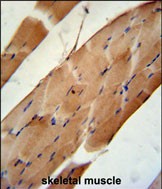CNO6L Antibody (C-term)
Affinity Purified Rabbit Polyclonal Antibody (Pab)
- SPECIFICATION
- CITATIONS
- PROTOCOLS
- BACKGROUND

Application
| WB, IHC-P, E |
|---|---|
| Primary Accession | Q96LI5 |
| Other Accession | Q8VEG6, Q5XH73, Q6IR85, Q8K3P5 |
| Reactivity | Human |
| Predicted | Xenopus, Mouse |
| Host | Rabbit |
| Clonality | Polyclonal |
| Isotype | Rabbit IgG |
| Calculated MW | 63001 Da |
| Antigen Region | 414-442 aa |
| Gene ID | 246175 |
|---|---|
| Other Names | CNOT6L; CCR4B; CCR4-NOT transcription complex subunit 6-like; Carbon catabolite repressor protein 4 homolog B |
| Target/Specificity | This CNO6L antibody is generated from rabbits immunized with a KLH conjugated synthetic peptide between 414-442 amino acids from the C-terminal region of human CNO6L. |
| Dilution | WB~~1:1000 IHC-P~~1:50~100 E~~Use at an assay dependent concentration. |
| Format | Purified polyclonal antibody supplied in PBS with 0.09% (W/V) sodium azide. This antibody is purified through a protein A column, followed by peptide affinity purification. |
| Storage | Maintain refrigerated at 2-8°C for up to 2 weeks. For long term storage store at -20°C in small aliquots to prevent freeze-thaw cycles. |
| Precautions | CNO6L Antibody (C-term) is for research use only and not for use in diagnostic or therapeutic procedures. |
| Name | CNOT6L |
|---|---|
| Synonyms | CCR4B {ECO:0000303|PubMed:17452450} |
| Function | Has 3'-5' poly(A) exoribonuclease activity for synthetic poly(A) RNA substrate. Catalytic component of the CCR4-NOT complex which is one of the major cellular mRNA deadenylases and is linked to various cellular processes including bulk mRNA degradation, miRNA- mediated repression, translational repression during translational initiation and general transcription regulation. Additional complex functions may be a consequence of its influence on mRNA expression. May be involved in the deadenylation-dependent degradation of mRNAs through the 3'-UTR AU-rich element-mediated mechanism. Involved in deadenylation-dependent degradation of CDKN1B mRNA. Its mRNA deadenylase activity can be inhibited by TOB1. Mediates cell proliferation and cell survival and prevents cellular senescence. |
| Cellular Location | Cytoplasm. Nucleus Note=Predominantly cytoplasmic. |
| Tissue Location | Highly expressed in placenta, skeletal muscle, pancreas, testis and leukocytes. Weakly expressed in heart, spleen and thymus. |

Thousands of laboratories across the world have published research that depended on the performance of antibodies from Abcepta to advance their research. Check out links to articles that cite our products in major peer-reviewed journals, organized by research category.
info@abcepta.com, and receive a free "I Love Antibodies" mug.
Provided below are standard protocols that you may find useful for product applications.
Background
CNO6L plays a role in the deadenylation of mRNAs in the cytoplasm. CNO6L has 3'-5' poly(A) exoribonuclease activity for synthetic poly(A) RNA substrate. CNO6L may be involved in the deadenylation-dependent degradation of mRNAs through the 3'-UTR AU-rich element-mediated mechanism. This protein involved in deadenylation-dependent degradation of CDKN1B mRNA.
References
Miyasaka, T., et al. Cancer Sci. 99(4):755-761(2008)
Morita, M., et al. Mol. Cell. Biol. 27(13):4980-4990(2007)
Ewing, R.M., et al. Mol. Syst. Biol. 3, 89 (2007)
If you have used an Abcepta product and would like to share how it has performed, please click on the "Submit Review" button and provide the requested information. Our staff will examine and post your review and contact you if needed.
If you have any additional inquiries please email technical services at tech@abcepta.com.













 Foundational characteristics of cancer include proliferation, angiogenesis, migration, evasion of apoptosis, and cellular immortality. Find key markers for these cellular processes and antibodies to detect them.
Foundational characteristics of cancer include proliferation, angiogenesis, migration, evasion of apoptosis, and cellular immortality. Find key markers for these cellular processes and antibodies to detect them. The SUMOplot™ Analysis Program predicts and scores sumoylation sites in your protein. SUMOylation is a post-translational modification involved in various cellular processes, such as nuclear-cytosolic transport, transcriptional regulation, apoptosis, protein stability, response to stress, and progression through the cell cycle.
The SUMOplot™ Analysis Program predicts and scores sumoylation sites in your protein. SUMOylation is a post-translational modification involved in various cellular processes, such as nuclear-cytosolic transport, transcriptional regulation, apoptosis, protein stability, response to stress, and progression through the cell cycle. The Autophagy Receptor Motif Plotter predicts and scores autophagy receptor binding sites in your protein. Identifying proteins connected to this pathway is critical to understanding the role of autophagy in physiological as well as pathological processes such as development, differentiation, neurodegenerative diseases, stress, infection, and cancer.
The Autophagy Receptor Motif Plotter predicts and scores autophagy receptor binding sites in your protein. Identifying proteins connected to this pathway is critical to understanding the role of autophagy in physiological as well as pathological processes such as development, differentiation, neurodegenerative diseases, stress, infection, and cancer.



